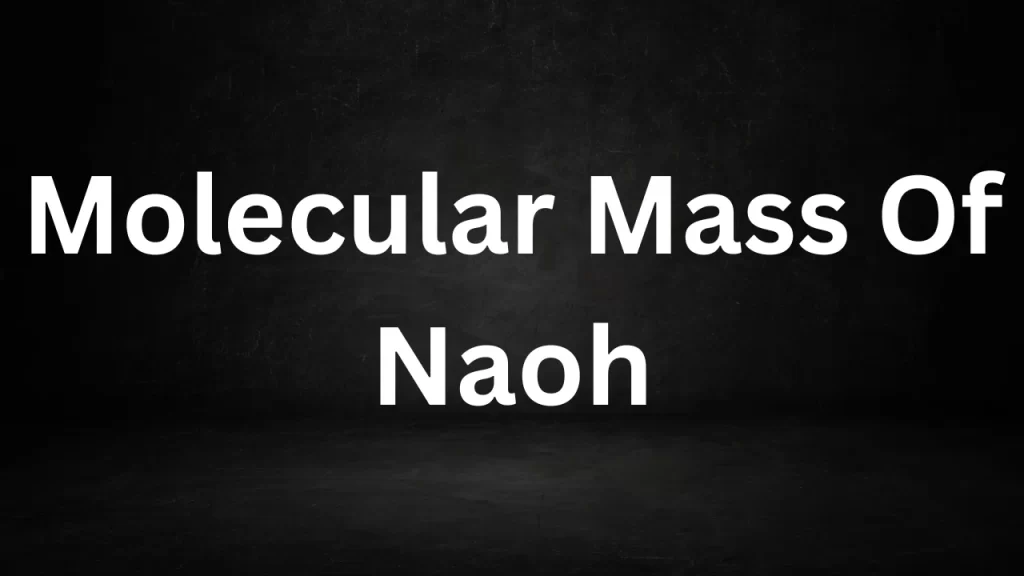Molecular Mass Of Naoh: Sodium hydroxide, commonly known as NaOH, is a chemical compound with a significant presence in various industrial and household applications.
Understanding the molecular mass of NaOH is fundamental to comprehend its properties and applications in chemistry, manufacturing, and everyday life.

Molecular Mass Of Naoh
The Basics of Molecular Mass
Molecular mass, also referred to as molecular weight or molar mass, is a critical concept in chemistry. It represents the mass of a molecule and is expressed in atomic mass units (u) or unified atomic mass units (AMU). Molecular mass is calculated by summing the atomic masses of all the atoms present in a molecule.
Composition of NaOH (Sodium Hydroxide)
NaOH, or sodium hydroxide, consists of three elements: sodium (Na), oxygen (O), and hydrogen (H). To determine its molecular mass, we need to consider the individual atomic masses of these elements.
- The atomic mass of sodium (Na) is approximately 22.98977 u.
- The atomic mass of oxygen (O) is approximately 15.999 u.
- The atomic mass of hydrogen (H) is approximately 1.00784 u.
Calculating the Molecular Mass of NaOH
To find the molecular mass of sodium hydroxide, we simply add the atomic masses of its constituent elements:
Molecular Mass of sodium hydroxide = (Atomic Mass of Na) + (Atomic Mass of O) + (Atomic Mass of H) Molecular Mass of sodium hydroxide ≈ 22.98977 u + 15.999 u + 1.00784 u ≈ 39.99661 u
Rounded to four decimal places, the molecular mass of sodium hydroxide is approximately 39.9966 atomic mass units (u).
Significance of NaOH’s Molecular Mass
Understanding the molecular mass of sodium hydroxide has several practical implications:
- Chemical Reactions: In chemical reactions involving sodium hydroxide, its molecular mass is crucial for stoichiometry calculations. It helps determine the amount of NaOH required or produced in a chemical reaction.
- Manufacturing and Industry: sodium hydroxide is a versatile industrial chemical used in processes such as soap and detergent production, paper manufacturing, and water treatment. Knowing its molecular mass is vital for precise formulation.
- Laboratory Work: In laboratory settings, scientists and researchers use the molecular mass of NaOH to accurately prepare solutions and calculate concentrations.
- Environmental Considerations: NaOH plays a role in wastewater treatment and pH adjustment. Understanding its molecular mass aids in controlling and optimizing these processes.
- Household Use: In households, NaOH is commonly found in drain cleaners and oven cleaners. Knowledge of its molecular mass is not only important for product efficacy but also for safety precautions.
- Conclusion
- The molecular mass of NaOH (sodium hydroxide), approximately 39.9966 atomic mass units (u), is a fundamental property of this essential chemical compound. It underpins its applications in various industries, chemical processes, and everyday products. Whether you’re a chemist, an industrial engineer, or simply someone using household cleaning products, an awareness of NaOH’s molecular mass is indispensable for understanding its role in numerous aspects of our lives.
Read More
- Molecular Mass Of Nitrogen
- Molecular Weight Of Glucose
- Molecular Mass Of Oxygen
- Difference Between Light Microscope And Electron Microscope
- Molar Mass Of Aluminium
Frequently Asked Questions (FAQs) Molecular Mass Of Naoh
1. What is the molecular mass of NaOH (sodium hydroxide)?
The molecular mass of NaOH, also known as sodium hydroxide, is approximately 39.9966 atomic mass units (u). This value is obtained by summing the atomic masses of the constituent elements in the compound: sodium (Na), oxygen (O), and hydrogen (H).
2. Why is it important to know the molecular mass of NaOH?
Understanding the molecular mass of sodium hydroxide is essential in various scientific, industrial, and practical applications. It aids in determining reactant and product quantities in chemical reactions, formulating solutions, and controlling processes in industries like manufacturing and wastewater treatment.
3. How is the molecular mass of NaOH calculated?
The molecular mass of sodium hydroxide is calculated by adding the atomic masses of its constituent elements, namely sodium (Na), oxygen (O), and hydrogen (H). The atomic masses can be found in the periodic table, and their sum gives the molecular mass of NaOH.
4. What are the common uses of NaOH in everyday life and industry?
Sodium hydroxide is a versatile chemical compound used in various applications, including soap and detergent production, paper manufacturing, water treatment, and household cleaning products like drain cleaners and oven cleaners.
5. Is NaOH’s molecular mass relevant in chemical reactions?
Yes, NaOH’s molecular mass is crucial in chemical reactions where it serves as a reactant or product. It helps chemists determine the stoichiometry of reactions and calculate the amounts of substances involved.
